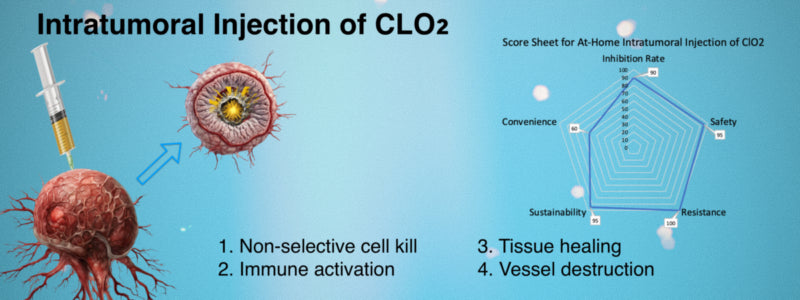
Discover the groundbreaking potential of intratumoral chlorine dioxide therapy for cancer treatment. Learn about its mechanisms, clinical outcomes, and why it represents a revolutionary approach to tackling tumors. Dive deeper into the science and latest updates on my Substack platform.


Active Collaboration: German and Brazilian Clinics
A German clinic and a Brazilian clinic have officially partnered with me, and both have already started offering chlorine dioxide intratumoral injection therapy as an alternative treatment for cancer patients in Europe and South America.

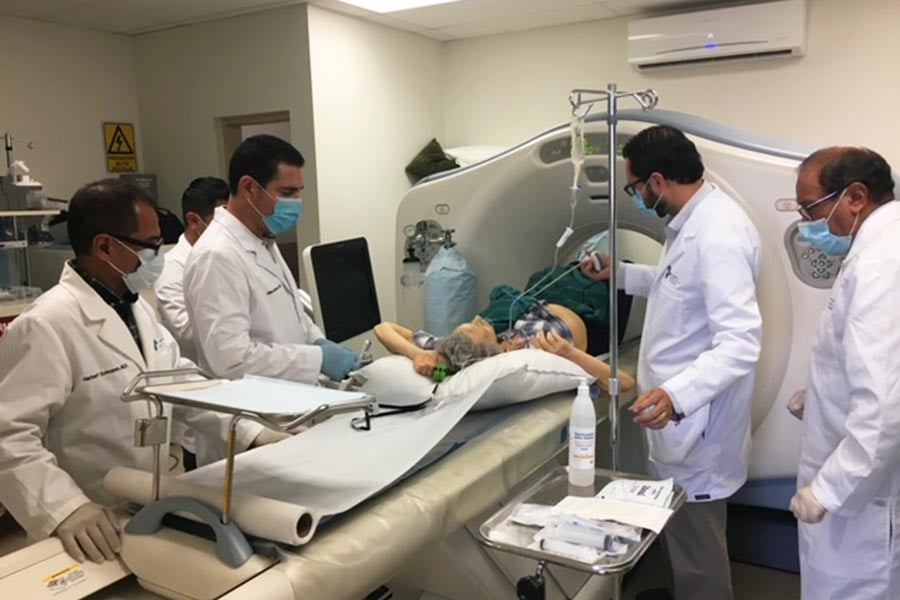
Clinic in Tijuana, Mexico Offering Intratumoral Injections
We collaborate with the ICCA clinic in Tijuana, which provides intratumoral chlorine dioxide therapy to patients worldwide. With extensive experience in intratumoral injections, it is the best partner for this therapy.


Philippine Partner Clinic: Akesis Holistic Health-Integrative Oncology
Dr. Homer Lim, Medical Director at the Philippine clinic, is very familiar with chlorine dioxide and well-versed in various CDS therapies. As an integrative oncology clinic, it can offer intratumoral chlorine dioxide treatments to cancer patients in the Philippines and throughout Asia.
Latest Clinical Findings from Germany: Intratumoral Chlorine Dioxide Therapy
-
Key Clinical Advances
- Successfully treated two late-stage cancer patients (vaginal and peritoneal cancer) in Germany.
- Tumor necrosis observed within 30 minutes of treatment via ultrasound.
- Significant inflammation reduction in and around the tumors.
-
New Mechanistic Insights
- Rapid tumor shrinkage not only due to cell necrosis but also inflammation resolution.
- Therapy addresses both tumor-induced compression and systemic complications.
-
Personal Observations
- High-concentration chlorine dioxide injection demonstrated effective inflammation elimination in both cancer treatment and joint arthritis cases.
-
Significance for Late-Stage Cancer Patients
- Tumor shrinkage relieves pressure on organs.
- Inflammation elimination prevents multi-organ failure.
- Therapy offers potential for prolonged survival and recovery.
The Primary Mechanisms of Intra-Tumoral Chlorine Dioxide (CD) Therapy for Treating Cancer
-
Direct Destruction of Cancer Cells:
CD’s strong oxidative properties allow it to kill cancer cells upon, a significant advantage over other injectable drugs (including intratumoral drugs and oncolytic viruses). With intra-tumoral therapy, we don't need to worry about maintaining CD in the tumor long periods, which a big challenge for many existing treatments.
-
Destruction of Tumor Blood Vessels:
High concentrations CD can directly damage tumor blood vessels. This means the tumor tissue doesn’t need to be completely saturated with CD; untreated tumor cells will die to lack of energy.
-
Induction of Systemic Anti-Tumor Immune Response:
CD can trigger a systemic immune response against tumors. In theory, patients don’t need to inject every single tumor. For small, untreated tumors at distant sites, CD’s systemic anti-tumor immune can effectively inhibit these small tumors.
-
Promotion of Tissue Regeneration:
CD has a mechanism that aids in tissue regeneration. For patients with advanced cancer, this is crucial because the reason they can't undergo surgery is the inability to heal large wounds post-tumor removal. When patients use CD, it can help regenerate tissue and heal any wounds formed tumor ablation.
5-Factor Assessment Framework-Intratumoral Injection of CLO2
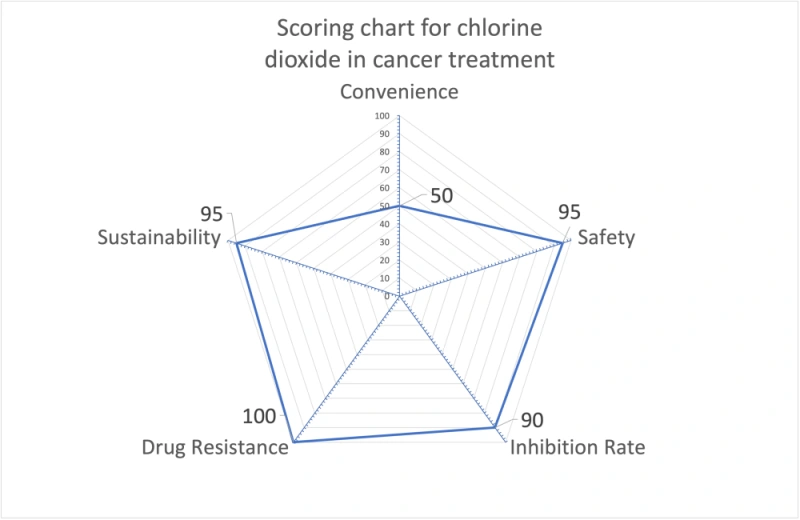
Why Intratumoral Chlorine Dioxide Injection Is Recommended
Challenges in Current Cancer Treatment
Currently, there are two predominant issues in cancer treatment. Firstly, the overall global standard of cancer treatment remains relatively low, with similar mortality rates among cancer patients worldwide, indicating minimal variation in treatment effectiveness between countries. Even in developed nations like the United States, considerable expenditure does not necessarily correlate with high treatment efficacy. Secondly, there is a prevalent problem of overtreatment, as doctors often overlook potential future side effects in pursuit of 100% cancer cell eradication, employing numerous inefficient or unnecessary treatment methods.
Importance of Evaluation Factors in Treatment
When evaluating the effectiveness of a cancer treatment approach, it is crucial to consider five factors: convenience, safety, inhibition rate, resistance, and sustainability. I emphasize that these five assessment factors can be deduced through a comprehensive cancer model, serving as the basis to determine the superiority of a treatment method. The optimal cancer treatment should excel in all these aspects to transform cancer into a chronic disease and extend the patient's high-quality survival period, which is the ultimate therapeutic goal humanity seeks.
Advantages of Intratumoral Chlorine Dioxide Injection
My intratumoral chlorine dioxide injection therapy excels in the framework of these five evaluation factors, surpassing any currently approved cancer treatments.
Mechanism and Benefits of Chlorine Dioxide Therapy
I am currently researching the use of chlorine dioxide in cancer treatment (specifically intratumoral chlorine dioxide injections). Chlorine dioxide shares similar properties with the immune system tool known as ROS and has been proven to destroy cancer cells and promote tissue repair. By directly injecting chlorine dioxide into tumors, it can selectively kill cancer cells without inducing resistance, trigger immune responses, and enhance treatment efficacy. This innovative approach utilizes chlorine dioxide's ability to mimic ROS, paving the way for a new avenue in cancer treatment.
Efficacy and Results of Intratumoral Chlorine Dioxide Therapy
In preclinical studies and select human trials, the benefits of intratumoral chlorine dioxide therapy for cancer treatment have become apparent: 1) precise tumor targeting leading to tumor dissolution, immune response stimulation, and disruption of tumor blood vessels, resulting in higher inhibition rates; 2) minimal side effects with intratumoral injections, promoting tissue regeneration post-tumor dissolution; 3) non-resistant pathways for tumor dissolution; 4) easy injections using standard needles; 5) the only downside being minor inconvenience compared to oral or intravenous therapies, a challenge that is expected to diminish with technological advancements.
Tumor Ablation Therapy is the Best Cancer Treatment, and Intratumoral Injection of Chlorine Dioxide is the Best Tumor Ablation Therapy
-
Tumor Ablation Therapy: The Best Cancer Treatment
Tumor ablation therapy represents a minimally invasive set of techniques aimed at specifically destroying tumor tissues. These therapies have become a cornerstone of treatment for cancers such as liver cancer, lung cancer, and kidney cancer. By precisely targeting tumors, ablation significantly reduces collateral damage, shortens recovery time, and elevates the quality of life for cancer patients.
Advantages of Common Tumor Ablation Methods
- Targeted and Precise
- Minimally Invasive
- Effective for Small, Localized, or Deep-Seated Tumors
- Reduced Systemic Side Effects
- Advanced, Noninvasive Options
- Versatility
-
Limitations of Traditional Ablation Methods:
- Limited Scope of Application: Ineffective for large, irregularly shaped tumors or those located near critical structures (e.g., major blood vessels or vital organs).
- Inflammatory Responses: Techniques like thermal ablation can trigger inflammation, swelling, and immune activation, potentially accelerating residual tumor growth or metastasis.
- Tissue Damage and Liquefactive Necrosis: Some methods may destroy surrounding tissues, causing infections or delayed healing.
- Complex Procedures: Ablation techniques can be time-consuming, making it challenging to treat patients with multiple tumors effectively.
-
Intratumoral Injection of Chlorine Dioxide: A Breakthrough in Tumor Ablation Therapy
Key Advantages of Chlorine Dioxide Therapy
- Complete and Precise Tumor Destruction
- Reduced Inflammatory Response
- Minimal Systemic Side Effects
- Repeatable and Flexible
- Simple and Cost-Effective
Chlorine dioxide therapy represents a safer, more effective, and versatile alternative to traditional tumor ablation techniques.
For Advanced Metastatic Cancer Patients
-

A Sustainable Treatment Option
Intratumoral chlorine dioxide injections offer convenient and sustainable treatment. Regardless of the stage of cancer progression, patients can engage in self-treatment at home without restrictions. This therapy is non-resistant, relies on immune response activation, and only requires injections into a few tumors rather than all.
-

Bringing Hope to Patients Abandoned by Hospitals
For late-stage cancer patients, hospitals often give up on treatment. However, intratumoral chlorine dioxide injections can offer hope to these patients due to their various anti-cancer mechanisms, allowing them to effectively treat advanced cancer.
-

Cost-Effective with Favorable Outcomes
Intratumoral chlorine dioxide therapy has three anti-cancer mechanisms: non-selective killing of cancer cells, immune system activation, and tumor blood vessel destruction. For late-stage cancer patients, each at-home self-treatment session is highly cost-effective with significant effects.
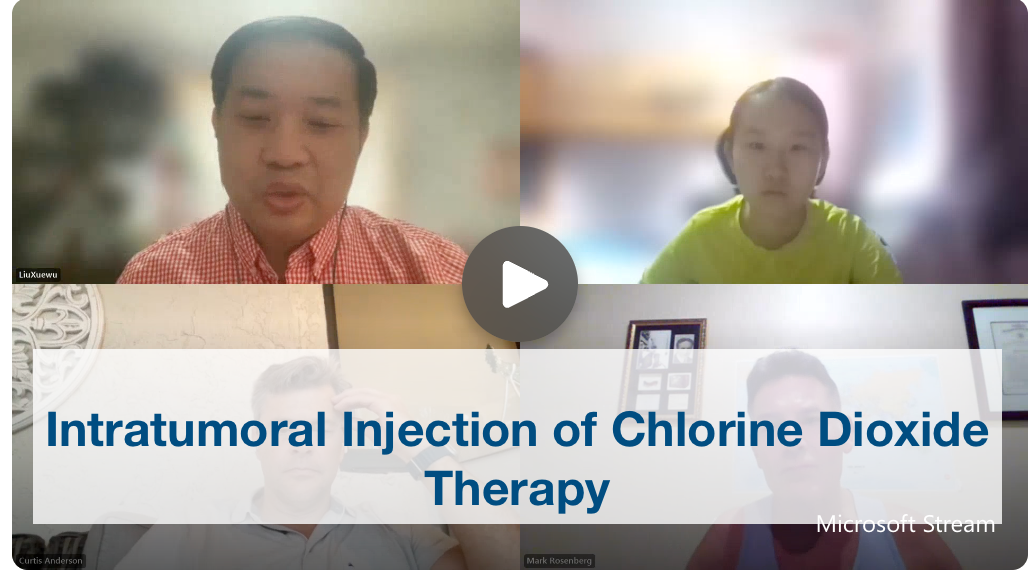
Discussion with Two American Oncologists on Intratumoral Chlorine Dioxide Therapy
On August 4th, my daughter and I held a video conference with two American oncologists to discuss intratumoral chlorine dioxide therapy. Both doctors, experts in oncology, including one specializing in interventional radiology, expressed disappointment with current advanced cancer treatments and showed significant interest in this new therapy.
Summary of Our Discussion
Background on Chlorine Dioxide
•It appears as a yellow-green gas at room temperature -Boiling point: 11 °C (52 °F)
•Solubility: In water, 3.01 g/L(3000ppm) at 25 °C and 34.5 mm Hg.
•Chlorine dioxide has gained popularity as an alternative therapy.
•Globally, medical use of chlorine dioxide is represented by MMS and CDS.
•Although few people know me, I am likely the person with the most applications for chlorine dioxide treatments for various indications globally.
Differences Between the Treatments in This Book and MMS, CDS
My Chlorine Dioxide Treatment:
•Involves directly delivering higher concentrations of chlorine dioxide to the affected area.
•Quickly treats various diseases, each with its own specific mechanism.
•All treatments in this book are supported by necessary validation data.
MMS:
•Involves significantly diluting high-concentration chlorine dioxide and ingesting it orally or via enema.
•Uses a water solution containing chlorine dioxide to treat various diseases.
CDS:
•Developed by Dr. h.c. Andreas Ludwig Kalcker as an improvement to MMS.
•Features a saturated chlorine dioxide solution (concentration around 0.3 mg/ml or 3000 ppm).
•Delivery methods mainly include diluted oral intake or intravenous injection. Sometimes other methods are used but at lower concentrations than 3000 ppm.
My Work on Chlorine Dioxide Therapy
•Discovered three mechanisms for treating diseases:
①Eliminating Abnormal Cells
②Promoting Tissue Regeneration
③Regulating Immune Response
•Detailed explanation available in the interview: Chlorine Dioxide Therapy Interview(Substack).
•Describes how chlorine dioxide effectively treats 13 diseases through these mechanisms.
The Chlorine Dioxide Miracle: Safeguarding Health with Safe and Effective Applications
Intratumoral Injection of Chlorine Dioxide Therapy
•Proposed the patent for intratumoral injection in 2014.
•Specific patent for preparation completed in 2016.
•Effective for arthritis and currently focused on cancer treatment, especially advanced cancer.
•Preclinical study report available: Preprint Link.
Personal Experience with Chlorine Dioxide Injections
•I have personally administered over 30 injections using high-concentration chlorine dioxide solution.
•Video Documentation:
•Safety Assurance:
•Based on my experience, I can assure you that chlorine dioxide injectables, when prepared more rigorously, are absolutely safe, even for healthy individuals.
Home Treatment of Advanced Breast Cancer
Current Cases:
•Three advanced breast cancer patients are currently under my guidance.
Treatment Method:
•High-concentration chlorine dioxide injections administered at home.
Current results:
- One injection dose under 10% of the tumor volume led to a 70% reduction in tumors over two months.
- Three patients with advanced breast cancer, each about three large tumors (over 4 cm in diameter), self-treated with 1-3 injections per tumor. Following the injections, they experienced pain but no other side effects.
My Book Introduces a Five-Factor Framework for Assessing Cancer Therapies
Using a five-factor framework:
•Inhibition Rate
•Side Effects
•Drug Resistance
•Sustainability
•Convenience
BOOK:《Confronting the Cancer Care Plight: Using First Principles to Navigate Your Cancer Journey》
The Primary Mechanisms of Intra-Tumoral Chlorine Dioxide (CD) Therapy for Treating Cancer
1.Direct Destruction of Cancer Cells:
–Strong oxidative properties allow chlorine dioxide to kill cancer cells upon contact.
–No need to maintain prolonged presence in the tumor, unlike many existing treatments.
2.Destruction of Tumor Blood Vessels:
–High-concentration chlorine dioxide can damage tumor blood vessels.
–Leads to untreated tumor cells dying due to lack of energy.
3.Induction of Systemic Anti-Tumor Immune Response:
–Triggers a systemic immune response against tumors.
–Effectively inhibits small, untreated tumors at distant sites.
4.Promotion of Tissue Regeneration:
–Supports tissue regeneration, aiding in healing post-tumor removal.
–Crucial for patients with advanced cancer who cannot undergo surgery due to difficulty in healing large wounds.
Comparative Advantages Over Traditional Ablation Methods
1. Convenience
Chlorine dioxide injections take only 10 seconds.
Enables at-home treatment with high convenience.
2. Higher Inhibition Rate
Directly kills cancer cells.
Destroys tumor blood vessels.
Triggers immune response.
3. Greater Sustainability
No limitation on tumor size.
Fast injection speed and low precision requirements mean almost no restriction on the number of tumors.
4. Lower Side Effects
Apart from pain, which can be managed with anesthetics and lasts about 24 hours, there are no other side effects.
Have you ever injected any tumors trans arterially? -The Interventional Radiologist's Professional Concerns
My response is that I have not performed transarterial tumor injections. However, I have considered it. Transarterial tumor injection would be very suitable for chlorine dioxide because it can effectively leverage the mechanism of tumor blood vessel destruction. Chlorine dioxide would immediately react with tumor arteries and the cells they supply, eliminating concerns about the retention time of chlorine dioxide within the tumor or its permeation into normal tissues. Therefore, if conditions permit, transarterial intratumoral injection of chlorine dioxide could be an ideal method in the future.
My Proposed Future Collaboration:
Promote Chlorine Dioxide Intratumoral Injection Therapy for Self-Treatment of Superficial Late-Stage Cancers:
For example, late-stage breast cancer. Self-treatment by patients is legal in any country and is their right. My future partners and I will offer courses and consultation services.
Currently, I offer courses and consultation services for late-stage breast cancer patients, charging each patient a $200 monthly subscription fee.
Collaborate with Interested Clinics:
I will provide the technology for free. Partner clinics can offer these treatments to various late-stage patients as an alternative therapy. All participating parties will share the profits.
I believe this can be tested in the United States and can quickly move forward in Mexico for collaboration.
Long-Term Goal: FDA Approval and Legal Sales in the United States:
Eventually, I aim to get this therapy approved by the FDA and legally sold in the United States and hope to collaborate on the new drug approval process.
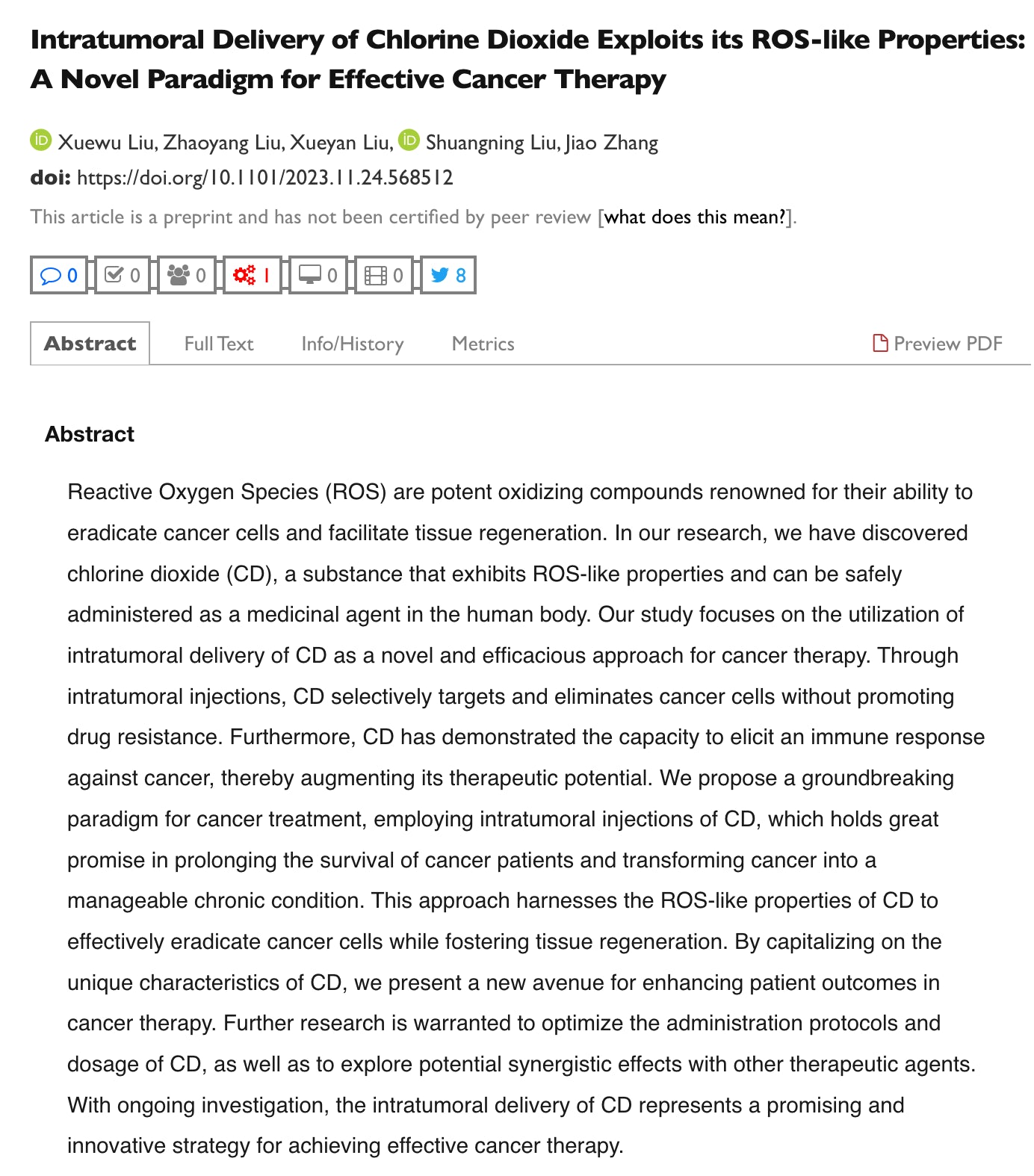
Preclinical Research Report on Intratumoral Chlorine Dioxide Injection
The world's first preclinical research report on using chlorine dioxide to treat cancer.
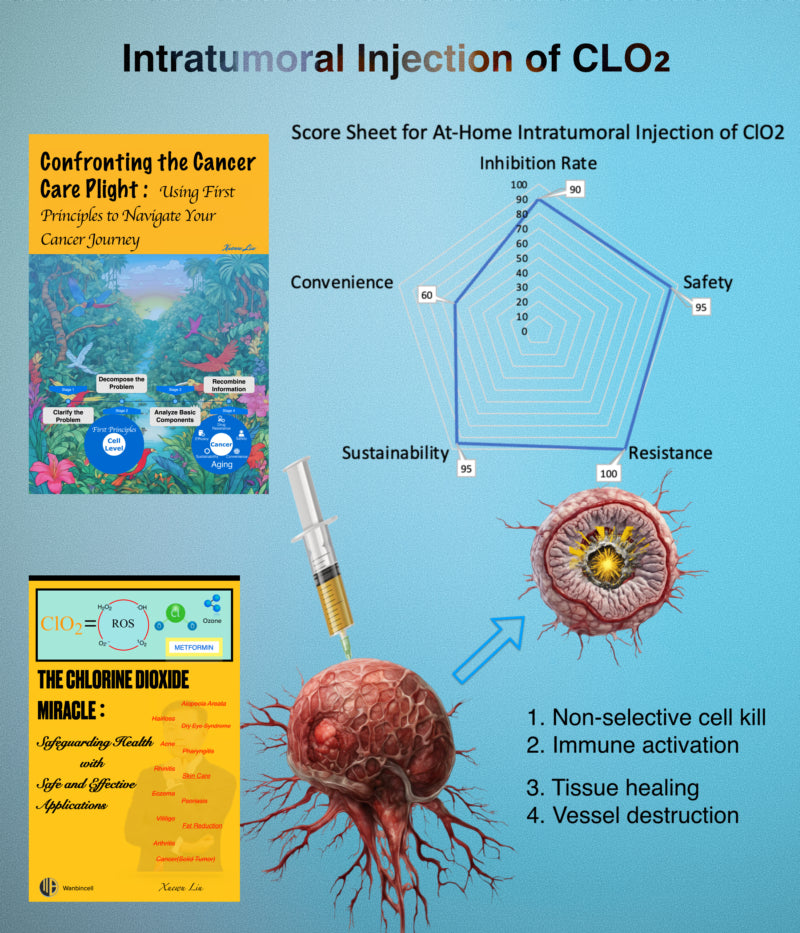
Contact Me to Learn Everything About Intratumoral Chlorine Dioxide Injection
Based on "The Chlorine Dioxide Miracle" and "Confronting the Cancer Care Plight," intratumoral chlorine dioxide injection emerges as a leading treatment for select cancer patients with limited options. This method, addressing inhibition rate, safety, resistance, sustainability, and convenience, offers a transformative approach towards cancer, converting it into a manageable chronic condition, devoid of mortality concerns.



